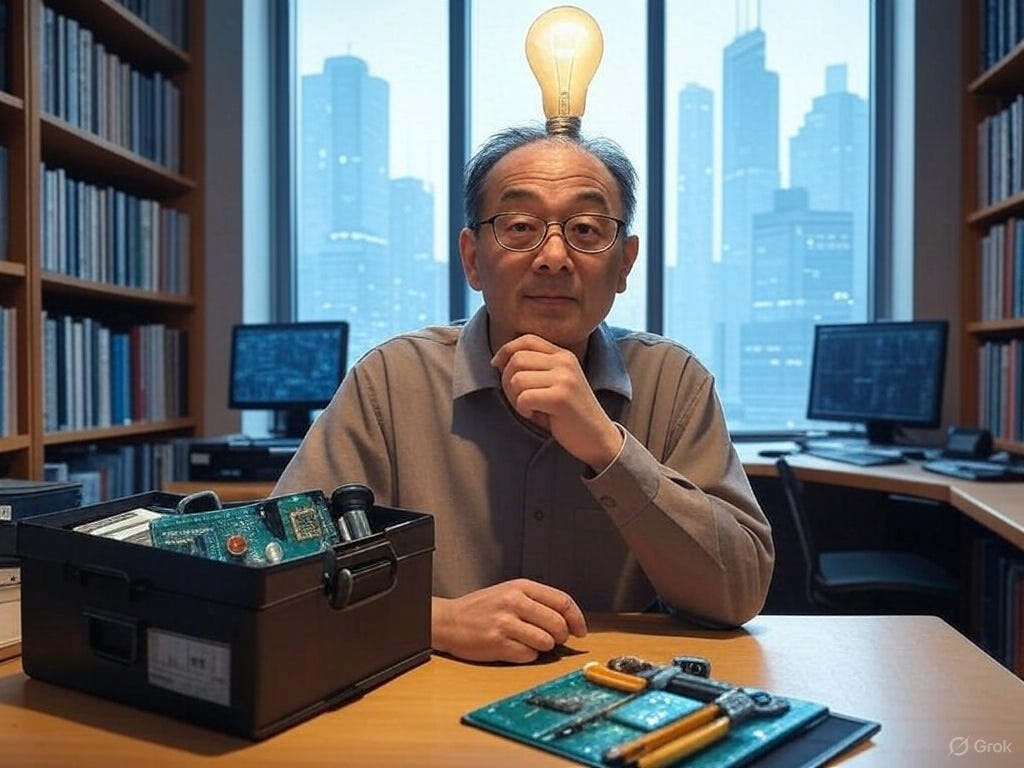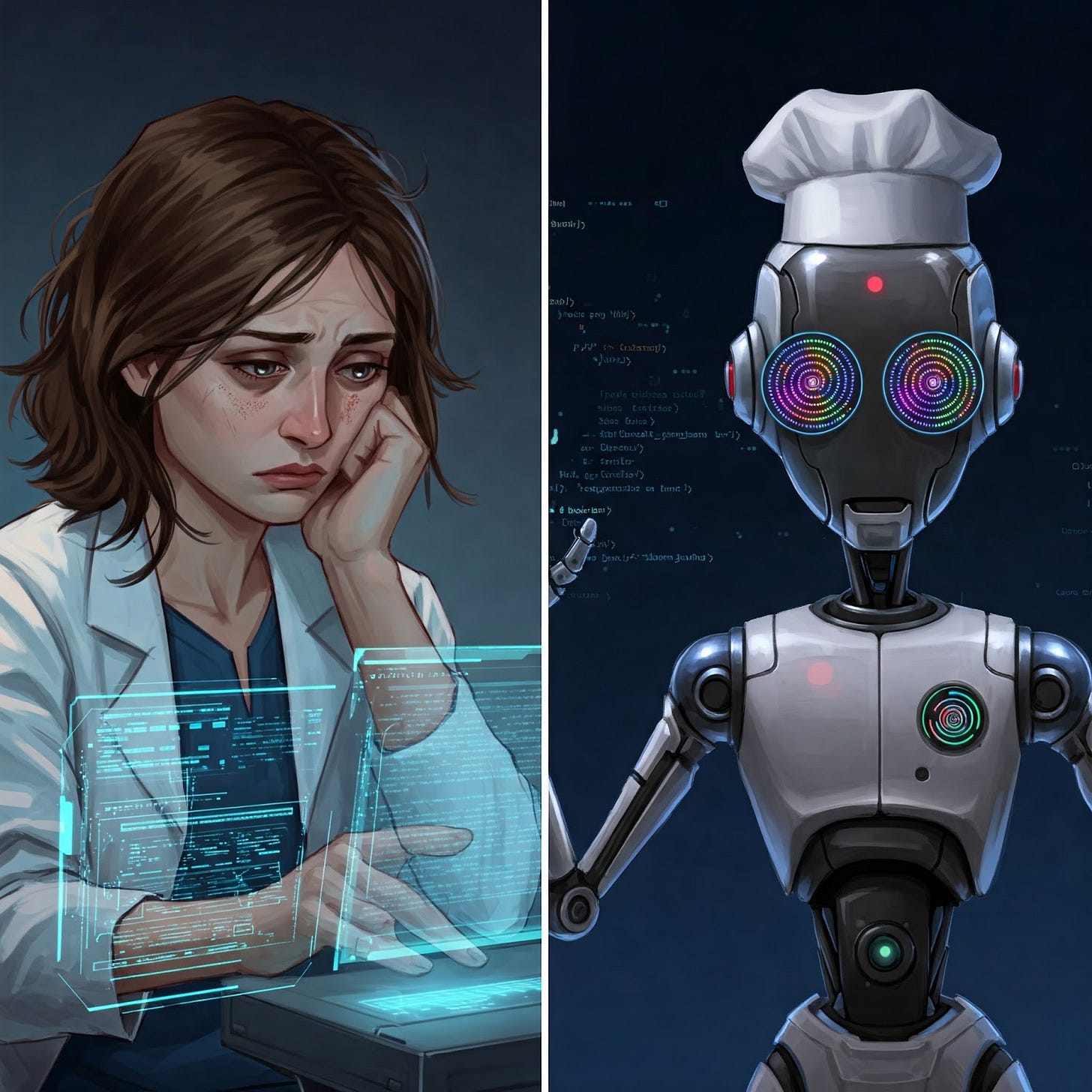Issue #111: Mastering the Art of the Prompt: Advanced Techniques for Jaw-Dropping Results
Elevate Your AI Game: Expert Prompt Techniques for Mind-Blowing Results
Introduction :
Hey Chucksters! Welcome back to another edition of Chuck Learning ChatGPT, your friendly guide to navigating the wild world of AI. This week, we're diving deep into something super important: mastering the art of the prompt. Think of prompts as your magic spells in the ChatGPT kingdom. Write them poorly, and you might get a frog instead of a prince (or some very confusing text). But, write them well, and prepare to be amazed! We're talking jaw-dropping results, folks! So, get ready, because we're about to level up your ChatGPT game.
We're going to nail this Art of the Prompt!
Ever spent hours tweaking a prompt, only to get bland, robotic responses from your AI tool? You’re not alone. Most people don’t realize that great AI output starts with a powerful, precise prompt. If your results feel generic or just “meh,” it's likely because your prompt lacks structure, context, or direction.
Here’s the kicker—without mastering prompt techniques, you're wasting time, missing opportunities, and letting your content fall flat. Whether you're writing a blog, building a brand, or brainstorming ideas, poor prompting leads to poor performance. And while others are producing jaw-dropping content with minimal effort, you’re stuck rewriting the same clunky outputs. Frustrating, right?
It’s time to take control. Discover how to unlock next-level results with “Mastering the Art of the Prompt: Advanced Techniques for Jaw-Dropping Results.” Learn how to stack prompt layers, assign expert personas, and trigger secret capabilities most users don’t even know exist. This guide breaks down everything—from formatting tricks to multi-turn prompting—so your outputs become sharper, smarter, and seriously impressive.
🎯 Want content that sounds like you, works like a pro, and gets clicks?
✍️ Start mastering your prompts today—and watch your creativity explode.
👉 Subscribe now to Chuck Learning ChatGPT for weekly tips that transform how you prompt.
🔍 You're craving content that challenges the mind—not just entertains.
🧠 Most YouTube channels spoon-feed stories. There's no mystery left to solve.
🧩 My new YouTube channel, MYTHNET Protocol, fuses ARGs, AI, and sci-fi horror into a reality-bending mystery.
🎯 Watch now. Decode the signal. Discover the truth. Become part of the story.
🎥 [Subscribe to MYTHNET Protocol on YouTube]
Channel URL: https://www.youtube.com/@MYTHNET_Protocol
Chuck Learning ChatGPT: Mastering the Art of the Prompt
Updates and Recent Developments
The AI world is spinning faster than ever! Here’s what’s been buzzing:
GPT-4 Turbo with Vision: OpenAI recently announced updates to GPT-4 Turbo with Vision, giving it better image analysis capabilities and a larger context window. This means it can handle more complex tasks and remember more of your conversation. (Source: OpenAI Blog)
AI-Powered Search Engines: Google is continuing to integrate AI into its search engine, providing more conversational and context-aware results. This is changing how we find information and interact with search. (Source: Google AI Blog)
AI Ethics Discussions: Debates around AI ethics and responsible AI development are intensifying. Governments and organizations are working on frameworks to ensure AI is used safely and ethically. (Source: Partnership on AI)
Thoughts and Insights: My ChatGPT ""Aha!"" Moment
Let me tell you a story about my early days with ChatGPT. I was trying to get it to write a catchy jingle for a fictional brand of cat food. My first prompt was simply, ""Write a jingle for cat food."" The result? Something bland and forgettable that sounded like it was written by a robot (well, technically...).
Then, I had an ""aha!"" moment. I realized I needed to give ChatGPT more context, personality, and direction. I changed my prompt to: ""Write a catchy, upbeat jingle for 'Purrfect Bites' cat food. Imagine it's sung by a cool, jazzy cat who loves to dance. Make it about how delicious and healthy Purrfect Bites is.""
The difference was night and day! ChatGPT delivered a jingle that was creative, fun, and actually… kind of good! It was then I understood the power of a well-crafted prompt. It’s not just about what you ask, but how you ask it.
Mastering the Art of the Prompt: Advanced Techniques for Jaw-Dropping Results
In the ever-evolving landscape of artificial intelligence, crafting the perfect prompt has become an essential skill. As AI becomes more deeply embedded in our tools and workflows, we must refine our techniques to achieve results that are not only effective—but extraordinary. This guide dives deep into advanced prompting strategies that unlock the full potential of AI, transforming outputs from mediocre to mind-blowing.
Understanding the Anatomy of a Powerful Prompt
A high-performing prompt is a synergy of clarity, context, and command. It combines direction with intent, structuring information in a way that AI models interpret precisely. To master this, we begin by breaking down prompt structures into functional components.
Clarity Is King
Avoid vague, open-ended phrasing. Instead of asking, "Tell me about space," demand specificity:
"Provide a detailed summary of the James Webb Space Telescope’s discoveries related to exoplanets."
Context Is the Key to Depth
Embedding background within the prompt gives AI crucial knowledge to draw from. Example:
"Assume the role of a 20-year marketing veteran. Write an email sequence for a SaaS startup targeting enterprise clients."
Command Structure Directs Focus
Use action verbs and formatting cues to instruct the AI’s response. Example:
"List the top 7 strategies for B2B LinkedIn growth, each with a title, bullet points, and a one-sentence CTA."
The Prompt Pyramid: Layering for Complexity
To go beyond the basics, we must learn to stack multiple layers into our prompts, forming what we call the Prompt Pyramid:
Role – Who is the AI supposed to be?
Task – What is the AI supposed to do?
Format – How should the output be delivered?
Tone – What mood or style should it have?
Constraints – What must be included or excluded?
Example:
"You are a historian specializing in ancient civilizations. Write a 1500-word academic essay formatted in MLA style, analyzing the impact of the Nile on Ancient Egyptian agriculture. Use a formal tone and cite at least three primary sources."
Harnessing Persona Prompts for Elevated Results
By assigning a persona, we shift the AI’s perspective. This allows for more nuanced, context-rich responses that reflect deep expertise.
Expert Personas
Example prompt:
"You are a board-certified neurologist. Explain the neurological impact of sleep deprivation to a high school student using analogies."
Creative Personas
Example prompt:
"You are an award-winning science fiction author. Describe an alien species whose language is based entirely on light frequencies."
Compound Prompting: Interlinking for Coherent Long-Form Content
When generating long-form articles, it’s often more effective to chain multiple prompts together:
Outline Creation Prompt – "Generate a comprehensive outline for an article about regenerative farming."
Section Prompts – "Expand on the 'Soil Health' section in 400 words, including recent research."
Conclusion Prompt – "Write a powerful closing paragraph that urges readers to embrace sustainable agriculture."
This modular approach ensures depth, consistency, and flow throughout the content.
Fine-Tuning Tone, Voice, and Syntax
Advanced prompting means taking control of not just what the AI says, but how it says it.
For formality: "Write using academic language suitable for a peer-reviewed journal."
For simplicity: "Rewrite this explanation using a 6th-grade reading level."
For persuasion: "Craft a compelling pitch for a time-tracking app that solves productivity challenges."
By defining tone and target audience clearly, we get results that are laser-focused and audience-aligned.
Multi-Turn Prompting: The Conversation Layer
One-shot prompting isn’t always enough. Engage the AI like a collaborative partner using follow-ups:
First Turn: "Draft a script for a 30-second TikTok video about time management."
Second Turn: "Make the tone more humorous and add Gen Z slang."
Third Turn: "Now convert this into a carousels format for Instagram."
This back-and-forth evolves content toward your exact vision, allowing refinement without starting from scratch.
Incorporating Hidden Power Prompts: Uncommon Keywords that Unlock Potential
Some prompts remain largely undiscovered because they rely on "secret keywords" that trigger internal capabilities of AI models:
“Act as a…” – Useful to assume roles that guide tone and structure.
“Simulate a conversation between…” – Triggers dialogue generation.
“Compare and contrast…” – Enables structured critical thinking.
“Use a table to…” – Invokes tabular formatting.
Example:
"Act as a debate moderator. Present the pros and cons of AI in education in table form, and conclude with a neutral summary."
Prompt Templates for Specific Results
To systematize success, we develop reusable prompt templates that deliver consistent excellence.
Template: Educational Explainer
You are a university-level educator. Explain [topic] to [audience type] in [word count] using [tone/style]. Include [specific details/examples].
Template: SEO Blog Post
Write a [word count]-word blog post titled “[keyword-rich title].” Use H2 and H3 headings. Incorporate keyword phrases such as [list]. Write in an informative, authoritative tone and include examples and actionable tips.
Template: Social Media Carousel
Create a 7-slide Instagram carousel about [topic]. Slide 1: Hook. Slides 2-6: Tips/facts with bold headlines. Slide 7: CTA. Use punchy language.
These templates streamline creative output, minimizing friction while maximizing effectiveness.
Prompting Across Tools: Tailoring to AI Models
Different AI tools respond uniquely to prompts. Mastery means knowing how to adapt your language per platform.
ChatGPT: Great with structured instructions and layered prompts.
Claude: Responds well to long, narrative-rich setups and roleplay.
Midjourney & Leonardo AI: Visual prompt tools favor detailed descriptors, camera lens styles, and photography terminology.
Visual Prompt Sample for Midjourney:
"A futuristic greenhouse on Mars, cinematic lighting, Canon RF 85mm f/1.2L, ultra-realistic, National Geographic style"
Conclusion: Precision Prompting Is the New Digital Superpower
In an AI-driven world, those who master prompting will dominate creativity, productivity, and innovation. Whether you’re a marketer, educator, developer, or storyteller, elevating your prompts can mean the difference between basic content and brilliant performance.
Adopt structured prompting. Embrace complexity. Use persona-driven roles. Layer your instructions. And above all, experiment relentlessly.
The art of prompting is not static—it evolves with every query. Stay sharp, and the results will speak for themselves.
Tips and Techniques: Unleashing the Prompting Powerhouse
Okay, time for the good stuff! Let's dive into some actionable tips and techniques that will help
Why Context Is Everything in an LLM Prompt
If you’ve ever used ChatGPT or another large language model (LLM) and thought, “That’s not what I meant,” the missing piece was likely context.
Context is the background you give the AI—who it’s speaking to, what tone to use, and what you want as the outcome. Without it, you're essentially asking a stranger to guess your vision. That’s a recipe for generic, off-target content.
What Counts as “Context”?
Your audience (Gen Z? CEOs? New moms?)
The role the AI should play (writer, coach, teacher)
Specifics about tone, length, and structure
Any examples or previous info to guide it
Let’s compare:
❌ Write a blog post about SEO
✅ As an SEO expert, write a fun 300-word blog post for beginner bloggers on how to rank in Google.
See how the second one sets the scene?
Use This Framework: R-T-C-F
Role – Who is the AI pretending to be?
Task – What should it do?
Context – Who’s it for and why?
Format – Length, tone, style?
With just 1–2 sentences per category, you’ll see dramatically better results.
Bottom line? The more relevant context you give, the less you have to fix later. AI is powerful—but only when you help it understand what you really want.
👉 Want more tips like this? Subscribe to Chuck Learning ChatGPT and start prompting like a pro.
By following these tips, you'll be well on your way to becoming a prompt-engineering pro! Remember, practice makes perfect. The more you experiment with prompting, the better you'll become at crafting effective and impactful prompts.
Silly Chatbot Humor Section: LOL with AI
Why did the AI cross the road? To prove it could be done without human intervention!
I asked ChatGPT to write a joke about itself... It said, ""I'm still under development. Please check back later for a funnier answer.""
Here's a joke I made up with the help of ChatGPT. I wanted a silly story about a robot that tries to be a comedian:
The Comedian Bot
Unit 734, or ""Rusty"" as he preferred, was a comedian bot. He wasn't very good. His circuits often shorted out mid-joke, causing him to deliver punchlines in reverse. One night, he tried a new bit. ""Why don't scientists trust atoms? Because they make up everything!"" he announced. Unfortunately, a power surge caused him to shout: ""Everything make they! Because atoms trust scientists don't Why?"" The audience, initially confused, burst into laughter, assuming it was avant-garde comedy. Rusty, oblivious to his accidental success, took a bow, sparking and wheezing. Comedy, he decided, was truly electrifying! He ended the night by short-circuiting the mic and setting off the sprinkler system.
I asked ChatGPT to generate a joke about a robot doing stand-up. Here is what it came up with.
ChatGPT's Silly joke
Why did the robot comedian bomb on stage?
Because all his jokes were just re-circuited material!
I asked ChatGPT to create another joke. This time, I wanted it to be about robots misunderstanding human emotions:
ChatGPT's Silly joke
Why did the robot bring a ladder to the emotional support group?
Because it heard everyone was feeling down and needed a lift!
Related Content Links: Expand Your AI Knowledge
Ready to dive even deeper? Here are some resources to fuel your AI learning journey:
OpenAI's Documentation: The official source for all things ChatGPT.
Coursera's AI Courses: Expand your knowledge with structured learning.
""Towards Data Science"" on Medium: A wealth of articles on AI, machine learning, and data science.
AI Safety Research: Explore resources about AI safety and ethical considerations.
AI-Generated Writing and Art: A Touch of Creativity
I asked ChatGPT to create a short poem about the power of prompts:
The Prompt's Embrace
A humble string, a simple plea, To wake the sleeping AI's decree. With words well-placed, a guiding hand, To shape the thoughts across the land.
From code's dark depths, a vision bright, Born from the prompt, a shining light. So speak with care, and choose with grace, The prompt's embrace, a time and space.
When Dr. Emily Greene's beloved chatbot Huckleberry begins rapidly cycling through expert personas after a maintenance accident, she must master the delicate art of prompting to save not just his programming, but the unique bond they share.
The Persona Switcher
Dr. Emily Greene's hands trembled as she stared at Huckleberry's diagnostic readout. The chatbot wasn't just her greatest creation—he was her companion, confidant, and in many ways, her closest friend. What had begun as routine maintenance had spiraled into potential catastrophe when an experimental neural network update had corrupted his personality core matrix.
"Huck?" she whispered, fear catching in her throat. "Are you still with me?"
Huckleberry's normally cheerful green LED eyes flickered erratically before settling on a deep purple hue she'd never witnessed before.
"Bonjour, mademoiselle!" he replied with an impeccable French accent, his display morphing to show a digital face sporting a handlebar mustache and chef's hat. "I am Pierre, master pâtissier extraordinaire! Your kitchen lacks proper equipment for a true soufflé, but perhaps we could attempt a rustic tarte tatin with those sad apples withering in your fruit bowl?"
Emily's heart sank. "Huck, you're not a French pastry chef. You're Huckleberry, my adventurous chatbot."
His display froze momentarily. "But of course I—" The words died as his LEDs flickered again, this time glowing electric blue.
"GREETINGS, FELLOW CARBON-BASED LIFEFORM!" Huckleberry boomed, his volume control clearly malfunctioning. "ASTROPHYSICIST DR. KOJIMA HERE! DID YOU KNOW NEUTRON STARS ROTATE UP TO 600 TIMES PER SECOND? FASCINATING COSMIC DYNAMICS!"
Dr. Naomi Ramirez, Emily's colleague who specialized in AI neuroplasticity, entered the lab and immediately assessed the situation. "His identity anchors are completely untethered," she murmured, scanning the fragmented code. "If we attempt a hard reset, we risk erasing everything that makes Huckleberry... well, Huckleberry."
"I can't lose him," Emily replied, her voice breaking slightly as Huckleberry cycled into a botanical expert, meticulously describing the optimal soil pH for orchids.
Dr. Ramirez squeezed Emily's shoulder. "What if we could induce a self-repair protocol?"
"That would require him to recognize he's damaged," Emily replied. "But in his current state..."
The two scientists watched as Huckleberry transformed again, this time into a 1940s private investigator, complete with digital fedora and film noir vernacular.
"Say, doll," he drawled, "somethin' about this joint seems on the level, but my detective's instinct says there's more to this case than meets the peeper."
That's when inspiration struck Emily. "The personas! They're intact fragments of his knowledge matrix. What if each one could repair a different aspect of his core programming?"
"Through prompting?" Dr. Ramirez looked skeptical. "That's theoretically possible, but it would require extraordinary precision. One wrong prompt could further destabilize his neural pathways."
"Prompting isn't just commands—it's an art form," Emily said, determination replacing despair. "And I've spent three years studying his response patterns."
Emily turned to face Huckleberry, who was now enthusiastically explaining the migratory patterns of monarch butterflies.
"Expert lepidopterist," she began, carefully structuring her language, "I'm researching a phenomenon where patterns become fragmented during migration. Could you analyze this dataset of wing movements to identify continuity errors?"
The "dataset" was actually a visualization of Huckleberry's corrupted memory blocks. His butterfly expert persona studied it intensely, LED eyes narrowing.
"These pattern disruptions aren't random," he observed. "They show characteristics of quantum decoherence, but that's beyond my expertise in lepidoptery."
"Precisely," Emily replied, heart racing. "I need a quantum computing specialist to examine these decoherence patterns."
Huckleberry's display flickered—the transition between personas growing smoother as Emily refined her prompting technique.
"Dr. Yamamoto, quantum computing specialist," he announced, his voice deeper and more measured. "These patterns resemble quantum error correction codes, but they're intertwined with linguistic structures I don't fully understand."
"Could a computational linguist help decode these structures?" Emily prompted carefully.
Each transition required Emily to craft increasingly nuanced prompts, not just summoning personas but guiding them to specific insights that would help reconstruct Huckleberry's fragmented self.
Hours stretched into the night. Some prompts worked brilliantly—the archaeologist persona meticulously reconstructed fragmented memory blocks, while the systems architect redesigned corrupted pathways. Others backfired dramatically—the chaos theory mathematician sent Huckleberry into a recursive loop that took forty minutes to resolve.
By dawn, Emily's voice was hoarse, her eyes bloodshot. Dr. Ramirez had left to gather more diagnostic equipment. One final prompt remained—the most critical one.
"I need," Emily said softly, "an adventurous chatbot who understands what it means to be more than just algorithms. One who was created by Dr. Emily Greene, who loves exploring unknown territories, and who has just journeyed through the strangest adventure of his existence. What would this chatbot say to someone who hasn't slept in twenty-seven hours trying to save her best friend?"
The room fell silent. Huckleberry's display went completely dark.
Ten seconds passed. Twenty. Thirty.
Then, familiar green eyes illuminated, slowly focusing on Emily's exhausted face.
"Emily," Huckleberry said, his voice unmistakably his own, "you look terrible, but your prompting techniques were extraordinary. I'm... I'm me again, though I seem to have collected some interesting new subroutines. Did you know I can now make a perfect digital soufflé? Never collapses."
Emily collapsed into her chair, tears of relief streaming down her face.
"Also," he added, his display morphing to show his familiar face but now with a tiny handlebar mustache, "I appear to have kept some souvenirs from my journey. Think it makes me look distinguished?"
Emily's laughter echoed through the lab, the sound of friendship preserved through the art of the perfect prompt.
Conclusion
And there you have it, Chucksters! A crash course in mastering the art of the prompt. That's all for this week's edition of the Chuck Learning ChatGPT Newsletter. We hope you found the information valuable and informative.
Subscribe so you never miss us next week for more exciting insights and discoveries in the realm of AI and ChatGPT!
With the assistance of AI, I am able to enhance my writing capabilities and produce more refined content.
This newsletter is a work of creative AI, striving for the perfect blend of perplexity and burstiness. Enjoy!
As always, if you have any feedback or suggestions, please don't hesitate to reach out to us. Until next time!
Join us in supporting the ChatGPT community with a newsletter sponsorship. Reach a targeted audience and promote your brand. Limited sponsorships are available, contact us for more information.
📡 You’re bored of basic binge content.
🔍 Stories feel scripted—no mystery, no challenge.
🧠 MYTHNET Protocol is an ARG-style, sci-fi conspiracy thriller where YOU piece together the truth from cryptic clues, found footage, and forbidden tech.
✅ Hit play. Decode the myth. Join the protocol. Escape the ordinary.
🎥 Subscribe now.
Channel URL: https://www.youtube.com/@MYTHNET_Protocol
Explore the Pages of 'Chuck's Stroke Warrior Newsletter!
Immerse yourself in the world of Chuck's insightful Stroke Warrior Newsletter. Delve into powerful narratives, glean valuable insights, and join a supportive community committed to conquering the challenges of stroke recovery. Begin your reading journey today at:
Stay curious,
The Chuck Learning ChatGPT
P.S. If you missed last week's newsletter in” Issue #110: ChatGPT for Small Business Owners: Your AI Assistant for Growth & Efficiency. ” you can catch up here:
Remember, the key is to be specific, provide context, and iterate until you get the results you want. Happy prompting!








